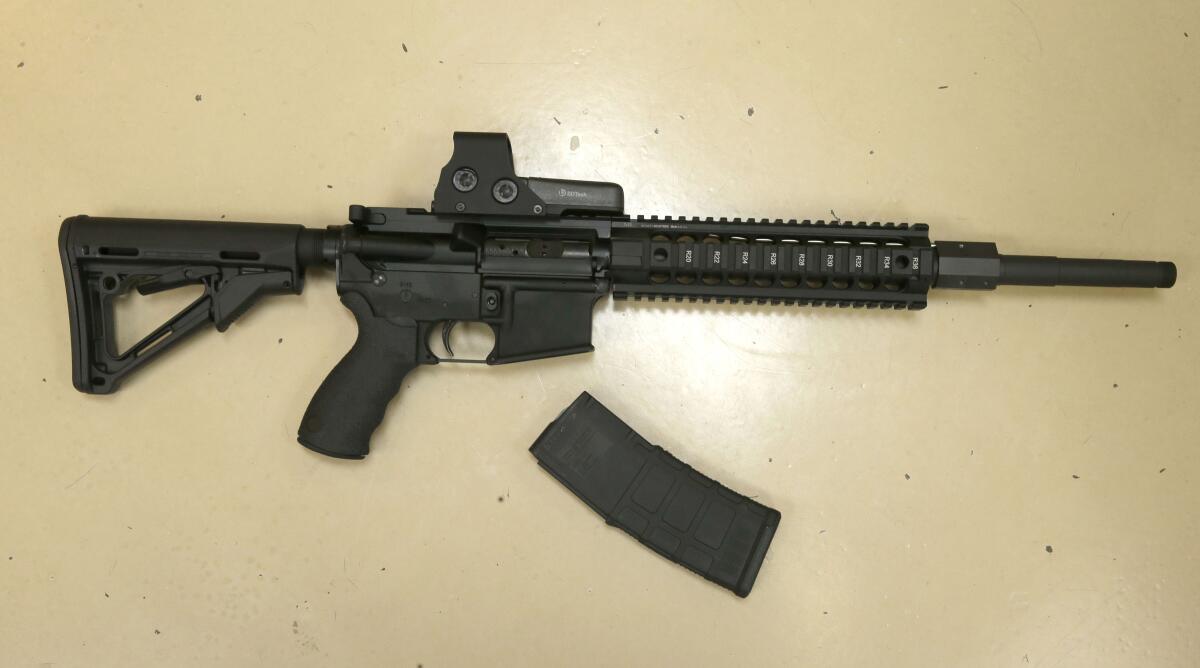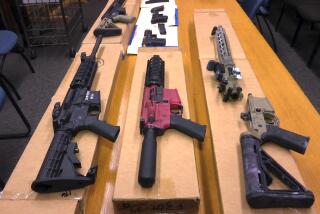9th Circuit stays ruling against California ban on high-capacity ammunition magazines

- Share via
The American debate over the legality of modern gun laws was again on display this week in the U.S. 9th Circuit Court of Appeals, where a panel of 11 judges hit pause on a decision overturning California’s ban on high-capacity ammunition magazines.
Last month, a lower federal court judge overturned that ban as unconstitutional. On Tuesday, the larger “en banc” panel stayed that decision — stopping it from taking effect — pending an appeal by the state.
The decision divided the judges along ideological lines. The court’s liberal majority found that the state of California had made “strong arguments” for why the ban on ammunition magazines with more than 10 rounds in them is constitutional. Even under a new, stricter test for gun laws set forth by the U.S. Supreme Court last year, the jurists found, the state is likely to win its appeal.
The majority wrote that California Atty. Gen. Rob Bonta’s office had presented evidence that large-capacity magazines “pose significant threats to public safety,” that there would be an “influx” of such magazines without a stay. The jurists added that such a stay would have “no effect” on the public’s ability to purchase a “wide range of firearms, as much ammunition as they want, and an unlimited number of magazines containing ten rounds or fewer.”
The majority also wrote that “public interest tips in the favor of a stay,” as “mass shootings nearly always involve large-capacity magazines.”
The panel’s conservative minority, dissenting, called their majority colleagues’ position “laughably absurd” and part of a pattern of decisions by liberal 9th Circuit jurists that has given “a blank check for governments to restrict firearms in any way they pleased.”
Circuit Judge Patrick J. Bumatay, a Trump appointee, accused the liberal majority of ignoring not only the U.S. Constitution but also the U.S. Supreme Court’s clear directives on how to properly analyze restrictions on the 2nd Amendment in its decision last year in New York State Rifle & Pistol Assn. vs. Bruen.
In that case, the Supreme Court found that modern gun laws must be deeply rooted in U.S. history or tradition, or be analogous to some historical law, to be constitutional.
Many experts viewed the decision as bringing an end to the sort of considerations articulated by the liberal majority in Tuesday’s order — such as whether a modern gun restriction serves the public interest by preventing things such as devastating mass shootings.
Instead, they said, courts under the Bruen ruling could only consider a modern law’s constitutionality by deciding whether it is sufficiently analogous to some historical weapons law — even if the weapons in question are entirely modern inventions.
The liberal majority in their order Tuesday found that courts across the country have ruled in similar ways on preliminary matters in high-capacity magazine cases since Bruen was decided, but did not engage in any of the historical analysis suggested by Bruen.
Bumatay — joined by the panel’s other conservative judges — blasted the majority for not providing a clearer explanation for their opinion that the state was likely to win its appeal under Bruen.
The majority decision provided “no serious engagement with the Second Amendment’s text,” Bumatay wrote. “No grappling with historical analogues. No putting California to its burden of proving the constitutionality of its law.”
“The Constitution and Californians deserve better,” he wrote.
Chuck Michel, president and general counsel for the California Rifle & Pistol Assn., is one of the plaintiffs in the case. He said in a statement that he was disappointed with the court’s “misinterpretation of the Bruen ruling” but “confident that the mandates of the Constitution and the Bruen decision will win in the end.”
He said his group “will continue to defend the rights of gun owners in California all the way to the Supreme Court.”
Bonta, in his own statement, said he was “relieved that the court considered the public safety of Californians” in its order.
“With the stay, California’s restrictions on large capacity magazines — a key component in our efforts to fight gun violence — remain in effect,” he said. “Californians should know that the purchase, manufacture or transfer of large-capacity magazines is against the law.”
Bonta said the Supreme Court was clear in its decision that Bruen “does not create a regulatory straitjacket for states and that cases should be evaluated on the text of the Second Amendment and its history and tradition of regulation,” and his office “will continue to fight for California’s authority to keep our communities safe from weapon enhancements that cause mass casualties.”
The en banc panel took the case after U.S. District Judge Roger Benitez of San Diego ruled in September that the ban is unconstitutional.
“This case is about a California state law that makes it a crime to keep and bear common firearm magazines typically possessed for lawful purposes,” Benitez wrote in his decision. “Based on the text, history and tradition of the 2nd Amendment, this law is clearly unconstitutional.”
It was the second time Benitez had overturned the law, the first since the Bruen decision was issued. Benitez has a history of overturning gun laws in the state.
The liberal en banc majority consisted of two Obama appointees and five Clinton appointees. Joining Bumatay in dissent were two other Trump appointees and an appointee of George W. Bush.
Judge Ryan D. Nelson, a Trump appointee, also wrote his own dissent, taking issue with the procedures used by the en banc panel to take up the case.
Adam Winkler, a UCLA law professor who focuses on 2nd Amendment law, said other post-Bruen courts — including those cited by the majority in Tuesday’s order — have upheld high-capacity magazine bans.
They’ve done so using arguments the Supreme Court left room for, he said, including that such weapons are not commonly used for self-defense, or that they present unique concerns that never confronted past generations.
However, the majority on Tuesday “didn’t seem like they made any real effort to grapple with the issues,” Winkler said. “There are good arguments to be made, but the court didn’t offer them.”
More to Read
Sign up for Essential California
The most important California stories and recommendations in your inbox every morning.
You may occasionally receive promotional content from the Los Angeles Times.














